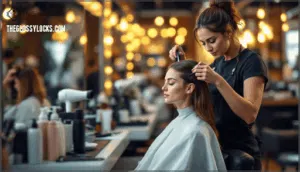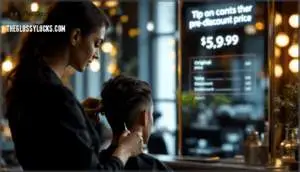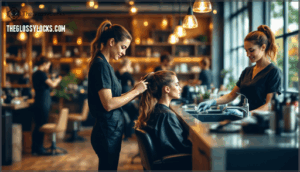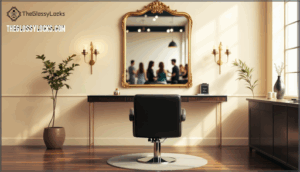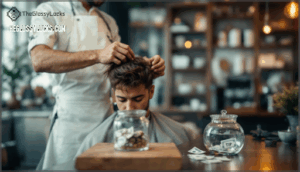This site is supported by our readers. We may earn a commission, at no cost to you, if you purchase through links.
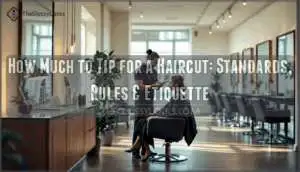 Last week, a client handed me a $5 tip on a $65 haircut and confidently walked out—completely unaware she’d just left less than 8%. The awkward silence that followed wasn’t about the money; it was about the disconnect between what she thought was generous and what’s actually standard in our industry.
Last week, a client handed me a $5 tip on a $65 haircut and confidently walked out—completely unaware she’d just left less than 8%. The awkward silence that followed wasn’t about the money; it was about the disconnect between what she thought was generous and what’s actually standard in our industry.
Here’s the thing: most people genuinely want to tip appropriately, but outdated advice and conflicting opinions have turned a simple gesture into a source of anxiety. The 15-20% range you’ve heard about? It’s real, but there are nuances around discounts, assistants, and service quality that can shift those numbers.
Understanding how much to tip for a haircut isn’t just about following rules—it’s about recognizing the value of skilled work and building better relationships with the people who keep you looking sharp.
Table Of Contents
- Key Takeaways
- How Much Should You Tip for a Haircut?
- Why is Tipping Your Hairdresser Important?
- How to Calculate The Right Tip Amount
- Should You Tip Hairdresser Assistants Separately?
- What if You Don’t Know Who Helped You?
- Do You Tip on Coupons or Discounts?
- Should You Tip The Salon Owner?
- When Should You Tip More or Less?
- What if You Can’t Afford to Tip?
- Is It Better to Tip in Cash or Digitally?
- Frequently Asked Questions (FAQs)
- How can I combine tips for multiple services?
- What other acceptable forms of payment are accepted for tips?
- How much should I tip for special occasions?
- How can I show appreciation for my stylist outside of tipping?
- Is there a minimum amount I should tip?
- Can you tip hairdressers with gift cards?
- Do salons add automatic gratuity for groups?
- Should you tip for free consultation appointments?
- How do you tip at booth rental salons?
- Is tipping required for hair extension services?
- Conclusion
Key Takeaways
- The standard tip for haircuts is 20% of the total bill (with 15% as the acceptable minimum and 25-30% for exceptional work), and you should always calculate tips based on the original pre-discount price—not what you paid after coupons or promotions—since your stylist’s effort remains the same regardless of your deal.
- Tips aren’t optional extras but essential income for hairdressers, making up 15-25% of their total earnings on top of base wages around $43,800 annually, which means your gratuity directly impacts their financial stability and livelihood.
- You should tip assistants separately in cash ($5-10 for shampooing, $10-20 for extended help) because they perform crucial behind-the-scenes work that enhances your experience, and most stylists prefer cash tips over credit cards since processing fees eat 1.5-3.3% and delay payment through payroll.
- Consistent, generous tipping builds stronger client-stylist relationships that last 4.3 years versus 2.6 years for inconsistent tippers, creating collaborative partnerships where your preferences are remembered and your needs are prioritized beyond routine service.
How Much Should You Tip for a Haircut?
Tipping your hairdresser doesn’t have to feel like guessing in the dark—there’s a clear standard that most stylists follow. The rule is simple: 20% of your total bill is the sweet spot, though 15% works if you’re watching your budget.
Here’s what that looks like in real dollar amounts and when you might tip more or less.
Standard Tipping Percentage
- 15% – The minimum acceptable gratuity for satisfactory service
- 20% – The industry standard and easiest tip calculation
- 25-30% – Reserved for outstanding work or complex styling
Typical Dollar Amounts by Service Cost
Let’s translate those percentages into actual dollars. For a $25 haircut, you’ll tip $4 to $6. A $50 service usually gets $7 to $12. Once you hit $75 to $100, expect to leave $11 to $25. Higher-end appointments follow the same logic: $125 to $150 services receive $25 to $37, while $200 to $300 color treatments usually get $40 to $75. Premium services above $300 often see gratuities between $60 and $90, especially when multiple specialists or extended sessions are involved.
Understanding tipping etiquette rules is essential for showing appreciation for good service.
Minimum and Maximum Tipping Guidelines
The floor for gratuity sits at 15%—anything less signals dissatisfaction in salon culture. That’s your baseline for standard cuts and average results.
Most stylists expect 20% as the comfortable middle ground, reflecting solid work without extras.
When you’re celebrating outstanding talent—intricate color corrections, bridal styling, or marathon sessions—push toward 25% to 30%. Tips beyond that range into rare territory, reserved for gestures of remarkable gratitude or holiday generosity.
Why is Tipping Your Hairdresser Important?
You might wonder why tipping matters so much in the salon world. The truth is, tips aren’t just a nice gesture—they’re a vital part of how hairdressers earn their living and how the entire industry operates.
Let’s break down three key reasons why your tip makes a real difference.
Hairdresser Compensation and Income
Most hairdressers earn around $43,800 annually, with tips making up 15–25% of total income. Base pay varies widely—from $34,000 to over $60,000—depending on regional disparities, commission structures, and whether you’re salon-employed or independent.
Benefit packages are rare, so gratuity directly impacts compensation and income stability for your stylist.
Industry Expectations
Across U.S. salons, tipping between 15% and 20% is standard, with 20% most widely accepted. Industry benchmarks show top-performing salons average 18% gratuity versus 14% among midrange locations.
These expectations shape hairdresser income stability since 67% of stylists say clients underestimate their reliance on tips. Your gratuity directly reflects service quality and reinforces salon etiquette standards that professionals depend on.
Relationship-building Through Tipping
Consistency creates connection. When you tip generously, you’re investing in a relationship that spans years, not just minutes.
Generous tipping builds lasting relationships with your stylist that span years, not just appointments
Stylists report 67% stronger rapport with clients who tip reliably, and those bonds last 4.3 years on average versus 2.6 years for inconsistent tippers.
This relational trust transforms routine appointments into collaborative partnerships where your stylist prioritizes your needs, remembers your preferences, and delivers tailored service quality that reflects your gratuity standard and respect for salon culture.
How to Calculate The Right Tip Amount
Figuring out the tip doesn’t have to feel like math class. A quick calculation method will help you land on the right amount without stress, and knowing how to handle discounts or split bills keeps things fair for everyone.
Here’s how to make tipping straightforward every time you leave the salon.
Easy Percentage Calculation Methods
You don’t need a calculator to nail your tip. Mental math tricks make it simple: find 10% by moving the decimal left one spot, then double it for 20%. Want 15%? Add half of that 10% to itself.
Most salon calculators and digital tools show instant percentage breakdowns, and over 70% of people now use their phone for gratuity math.
Rounding up to the nearest dollar keeps things clean and boosts your tip slightly, which stylists appreciate.
Tipping on Discounted Services
Here’s the truth: when you score a deal through a coupon or Groupon, your stylist still puts in the same work. You should tip 20% on the original, pre-discount price—not what you paid after the markdown. Nearly 80% of clients follow this rule because discounts are marketing costs, not reductions in your stylist’s effort or skill.
- Calculate your tip from the full service price before any discount is applied
- A $100 service with a 50% coupon still deserves a $20 gratuity, not $10
- Stylists usually earn only 10–15% commission, making fair tipping critical to their income
- Over 90% of salon professionals agree prediscount tipping reflects proper client etiquette
- Transparent salon policies often display reminders like "Please tip on original pricing" at checkout
Examples for Common Salon Bills
Let’s break down what you’d pay at different price points. For a $25 haircut, tip $5 (20%) or round to $4 if budget’s tight (15%). A $50 salon visit calls for $10 in gratuity—straightforward math that works every time.
Hit the $100 mark for color or styling? Hand over $20, or bump it to $25 (25%) when your hairdresser nails a tricky balayage.
Premium $150 services deserve $30, while $200 appointments earn $40 tips as the industry standard across payment methods.
Should You Tip Hairdresser Assistants Separately?
Yes, you should tip assistants separately—and here’s the thing: they’re doing real work that makes your experience better. If someone washes your hair, preps your color, or blow-dries your style, they deserve recognition beyond what goes to your main stylist.
Let’s break down what they do, how much to give them, and how to handle tips when multiple people pitch in.
Common Tasks Performed by Assistants
Salon assistants do the behind-the-scenes work that keeps your appointment running smoothly. Their efforts directly impact your comfort and the hairstylist’s ability to focus on your hair. Here’s what they usually handle:
- Client greeting and front desk support — welcoming you, managing coats, offering refreshments, and scheduling appointments
- Hair preparation services — shampooing, conditioning, detangling, and blow-drying before your stylist begins
- Salon sanitation and maintenance — disinfecting tools, sweeping hair, sanitizing chairs between clients
- Workflow optimization tasks — mixing color products, fetching tools, restocking supplies, and preparing workstations
These tasks free your hairdresser to concentrate on delivering outstanding results, making assistants essential to tipping etiquette and overall service quality.
Standard Tip Amounts for Assistants
Assistants usually receive $5 to $10 in cash for basic services like shampooing. If yours applied gloss or assisted with a complex blow-dry, consider $10 to $20 depending on their involvement. This assistant gratuity is separate from your hairstylist’s tip—it’s a key part of salon etiquette and assistant compensation.
Most salons expect flat-dollar tips for assistants rather than percentages, so keep cash handy for proper tip distribution.
| Service Level | Recommended Tip |
|---|---|
| Basic shampoo/rinse | $5–$7 |
| Shampoo + blow-dry assist | $8–$10 |
| Extended help (gloss, styling) | $10–$20 |
How to Distribute Tips for Multiple Helpers
When multiple people help during your appointment, you have a few options. Hand each assistant their own cash tip directly—this ensures everyone gets recognized. If you’re unsure who did what, ask the front desk to distribute your tip using envelopes or through their tip pooling system.
Some salons use points-based or hourly distribution models for assistant compensation, so check their salon policies. Discreet tipping through the receptionist keeps things smooth while respecting helper etiquette and tipping standard practices in the service industry.
What if You Don’t Know Who Helped You?
Sometimes you’ll walk out of a salon without a clear picture of who did what—especially in larger shops where multiple hands touched your hair. Don’t let that uncertainty keep you from tipping fairly. Here’s how to handle it when you’re not sure where your money should go.
Asking The Front Desk for Help
When you’re standing at checkout wondering who did what, just ask the receptionist—they’re trained for this. Over 60% of salon customers rely on front desk staff to guide tip distribution, especially when multiple people worked on your hair.
Most salons track who provided which service, so the team can divide your gratuity correctly. Don’t stress about getting it wrong—asking shows good salon etiquette and ensures everyone gets paid fairly.
Using Tip Envelopes or Pooled Tips
Many mid- to high-end salons provide small envelopes at checkout—you write your name and the stylist’s or assistant’s name on each, slip in cash, and hand them to reception for distribution. It’s discreet, professional, and ensures everyone gets their gratuity without awkward handoffs.
Some salons use pooled tip systems instead, where your total gratuity gets divided among the team automatically. Digital tip tools like eTip.io handle pooling transparently, though 83% of stylists still prefer envelope or direct cash tips for faster access and perceived fairness.
Salon-specific Tipping Systems
Each salon manages gratuity differently, so you’ll want to ask before you pay. Look for these common setups:
- Envelope systems — Reception provides labeled envelopes for each team member you want to tip.
- Digital tipping platforms — Tools like Tippy or eTip let you split gratuity by name or role at checkout.
- Pooled tip models — Your total gratuity gets divided among staff based on hours worked or service involvement.
When service charges appear on your bill, clarify whether they replace or supplement your hairstylist’s gratuity. 36% of clients tip less when they see fees, but most charges don’t reach your stylist directly.
Do You Tip on Coupons or Discounts?
Here’s the tricky part: when you score a deal with a coupon or Groupon, you still tip on the original price—not what you paid. Your stylist put in the same work whether you paid full freight or caught a discount.
Let’s break down why this matters and how to handle it smoothly.
Tipping on Pre-discount Totals
Here’s your insider rule: always tip based on what the service actually costs, not what you paid after a coupon or discount knocked the price down. If your colorist’s work was valued at $100 but a promotion brought it to $60, your gratuity should still reflect that original $100.
Industry data shows 92% of salons recommend this approach, and 61% of clients already follow it. Think of it this way—your stylist put in the same skill, time, and effort regardless of your deal. Tipping on pre-discount totals isn’t just tipping fairness; it’s how you honor the real value of the service pricing while respecting gratuity standards and discount policies.
| Original Price | Discounted Price | Recommended Tip (20%) |
|---|---|---|
| $80 | $50 | $16 |
| $120 | $75 | $24 |
| $200 | $140 | $40 |
Tipping etiquette is clear: the discount was your savings, but the tip belongs to the professional who earned it.
Why Discounts Don’t Lower Tip Expectations
Fairness dictates that discounts never dilute tip expectations—your stylist delivered the same expertise whether you paid full price or caught a deal. Here’s why Service Quality and Fair Wage Standards stay locked at 20% of the original total:
- Economic Factors hit hard: One in five stylists depends on tips for 20% of their annual income, and base wages hover around $17 hourly—discounts don’t change their rent or bills.
- Tip Consistency protects livelihoods: Commission structures mean your gratuity directly offsets what the salon cuts when offering promotions.
- Client Perception matters: Tipping etiquette recognizes that customer service, skill, and time remain unchanged—the discount was marketing, not a pay reduction for your pro.
Communicating With Your Stylist About Tipping
Awkward about tipping etiquette when you’ve used a discount? Open Communication solves this fast. Industry surveys show 62% of clients feel confused about gratuity norms—so just ask your hairstylist upfront about Salon Policies on discounted services.
A quick "Should I tip on the original total?" shows Gratitude Expression and Client Comfort. Tipping Transparency builds trust: stylists who discuss tip expectations openly receive 15% higher gratuities and stronger loyalty.
Should You Tip The Salon Owner?
This is one of those gray areas where old-school etiquette meets modern reality, and honestly, the rules aren’t as clear-cut as you’d think. Whether you tip a salon owner depends on a few factors—tradition, location, and the owner’s personal preferences all play a role.
Let’s break down when it’s expected, when it’s appreciated, and when you can skip it without breaking any unspoken rules.
Common Etiquette for Owners
Here’s the truth: tipping etiquette around salon owners has shifted dramatically over the past decade. What was once a firm "no-tip" rule is now murky territory, leaving you wondering what’s actually expected.
The current landscape looks like this:
- About 29% of clients still skip tipping owners entirely, sticking to the old-school belief that ownership equals financial independence
- 47% now tip when the owner personally performs their service, recognizing the hands-on labor regardless of business structure
- Regional differences matter—southern and coastal areas lean toward tipping owners around 22%, while inland regions average closer to 17%
- 60% of salon guests report genuine confusion about whether ownership changes their tipping obligation
The baseline? If your salon owner is actively cutting, coloring, or styling your hair, the standard 20% gratuity applies just like it would for any stylist.
When to Tip an Owner
You should tip a salon owner when they personally perform your service—cutting, coloring, or styling your hair. The standard 20% gratuity applies regardless of ownership status. Tipping salon owners acknowledges their hands-on work and follows current salon etiquette, especially as digital tips and automatic prompts normalize owner tipping.
Service fees don’t replace gratuities. If you’re uncertain about tipping guidelines or owner income structures, check the salon’s posted gratuity guidelines or ask discreetly at checkout.
Regional and Salon Policy Variations
Tipping norms shift based on where you live and each salon’s unique policies. In the U.S., 20% is standard, but UK gratuity hovers around 10-15%, while Japan rarely tips at all. Urban salons often expect higher percentages than rural shops, and some establishments pool tips among all staff.
Always check your salon’s posted tipping guidelines or ask at checkout—local customs and internal policies directly shape what’s appropriate for your hairdresser.
When Should You Tip More or Less?
The standard 20% tip isn’t set in stone—sometimes you’ll want to adjust it based on what you received. Your stylist’s effort, the outcome, and the timing of your visit all play a role in how much you leave.
Here’s when it makes sense to tip more or tip less.
Exceptional Service or Complex Styles
Mastery deserves recognition. When your hair stylist delivers standout service—think precision cuts, complex color jobs blending multiple tones, or custom designs requiring expert techniques—tipping 22–25% reflects the artistry involved.
High-end styling, especially work exceeding three hours or intricate transformations, warrants a 25–30% gratuity. Tipping etiquette rewards the technical skill and tailored attention that lift salon services beyond routine haircuts.
Dealing With Poor Service
On the flip side, poor service doesn’t eliminate tipping—but it does shift expectations. When customer service falls short or client frustration builds from poor communication, most clients reduce tips to 10–15% rather than the standard 20%.
That’s fair. If your stylist ignores your concerns or delivers subpar results, tipping ethics still matter, but you’re not obligated to reward work that misses the mark.
Address complaints directly—service recovery often salvages both the cut and the relationship, protecting customer satisfaction and service standards across the service industry.
Holiday or Special Occasion Tipping
During the holiday season, generosity flows freely—and your stylist notices. Many clients bump their standard 20% to 25–30% in December, or add a flat $25 bonus for long-standing relationships.
Holiday tipping isn’t required, but it’s deeply appreciated in commission-based work where gratitude payments supplement lower base wages. Seasonal gifts or bonus incentives show you value the trust built over time.
Tipping etiquette for barbers and hair salon pros alike means recognizing the hands that keep you looking sharp year-round.
What if You Can’t Afford to Tip?
If tipping 20% feels out of reach right now, you’re not alone—and there are respectful ways to navigate this. The key is being honest with yourself and your stylist about what works for your budget.
Let’s look at practical options that let you maintain a good relationship without breaking the bank.
Alternative Ways to Show Appreciation
You can’t tip in cash, but you can still honor tipping etiquette for barbers and stylists through meaningful gestures. Refer friends—referral incentives fuel business growth and matter more than you’d think. Book your next appointment before leaving to show commitment. Post a glowing review or tag your stylist on social media for visibility.
Small gifts like coffee cards or custom notes aligned with gift-giving etiquette guidelines express appreciation without breaking your budget. Loyalty programs reward repeat visits, so stay consistent. These alternatives to gratuity strengthen your relationship while respecting salon culture.
Communicating With Your Stylist
Occasionally, honest communication beats silence when finances are tight. Your hairdresser respects transparency—over 70% of appointment dissatisfaction stems from unclear communication between clients and stylists, so speaking up strengthens trust rather than weakening it.
- Schedule a consultation appointment before your service to discuss your budget openly and explore options that work for both of you
- Use visual references to guarantee you’re both aligned on expectations, reducing misunderstandings by roughly 60%
- Practice active listening during your conversation—stylists value client feedback and clear communication about financial constraints more than awkward silence
Most professionals appreciate directness over assumptions. This etiquette respects both your situation and their stylist expectations.
Budgeting for Salon Visits
Strategically, extending your cut from every six weeks to every eight weeks shaves roughly $50–$100 off annual haircare costs. Factor in 20% for tipping when you’re financial planning—setting aside money for each salon visit prevents surprise expenses.
Learning basic trim techniques at home can slash your beauty budgeting by up to 50%, giving you control over service pricing.
Prepaid packages and seasonal promotions help manage salon expense predictably, ensuring you’re never caught short when it’s time to tip your stylist fairly.
Is It Better to Tip in Cash or Digitally?
You’ve got options regarding how you hand over that tip—cash, card, or app. Each method has its pros and cons, and stylists definitely have preferences about what works best for them.
Let’s break down what you need to know so you can tip in a way that actually gets into your stylist’s hands.
Cash Vs. Credit Card Tips
Here’s the truth most clients don’t realize: your payment method directly affects how much of your tip your stylist actually keeps. Credit card tips often lose 1.5% to 3.3% to processing fees, and they’re delayed through payroll, creating tax withholding and wait times that cash avoids entirely.
- Cash puts 100% in your stylist’s hands immediately—no processing fees eating into your generosity
- Credit card tips get documented and taxed automatically—offering traceability but reducing take-home pay
- 72% of stylists prefer cash because it bypasses the "middleman" and arrives instantly, not days later
That’s why many stylists light up when you hand them bills—it’s not just convenient for you, it’s financially better for them.
Popular Digital Payment Platforms
Venmo, Cash App, and Zelle dominate the peer payments landscape—together handling billions in transactions annually. These digital wallets make contactless transactions smooth, letting you tip directly from your phone without fumbling for cash or running a credit card.
Many salons now display QR codes at checkout, connecting you instantly to your stylist’s mobile payment account. Just remember: platforms like PayPal or Apple Pay work too, but always confirm your stylist’s preferred method before tapping send.
Stylist and Salon Preferences
Here’s the reality: cash wins with stylists every time. A recent survey found 72% of hairdressers prefer cash tips because they receive the full amount instantly—no processing delays, no hidden fees eating into their gratuity. Meanwhile, only 19% favor credit card tips, and digital platforms like Venmo trail further behind at 21%.
That said, about 36% of stylists welcome whatever method works best for you. When you’re booking, just ask your salon about their tipping policies and your stylist’s preference—it shows respect for their livelihood and keeps expectations clear.
Frequently Asked Questions (FAQs)
How can I combine tips for multiple services?
You’ll calculate your tip on the total bill, then split it among everyone who touched your hair.
Most salons follow a simple rule: tip twenty percent on the entire service cost, not per person. If your stylist colored for $60 and another cut for $40, that’s $20 total—not $20 each.
What other acceptable forms of payment are accepted for tips?
You can tip using cash, credit or debit card, or digital payment apps like Venmo, PayPal, and Zelle.
Many salons now accept contactless tipping through QR codes and mobile wallets like Apple Pay or Google Pay.
How much should I tip for special occasions?
Think of a wedding day as opening night—every detail matters more. For special occasions like bridal styling or holiday appointments, tip 20-25% of the total service cost.
During holidays, consider adding an extra 10% or a thoughtful gift card to show appreciation for outstanding event hairdos and luxury services.
How can I show appreciation for my stylist outside of tipping?
Leave glowing online reviews on Google or social media—they build your stylist’s reputation and attract new clients.
Refer friends and family; referrals are gold for hairdressers.
Rebook before leaving to show loyalty, and share transformation photos tagging your stylist for visibility.
Is there a minimum amount I should tip?
While there’s no universal rule, $5 is usually the practical floor for standard haircuts—even on a $25 service.
Most stylists rely on tips as essential income, so sticking to the 15-20 percent guideline ensures fair compensation.
For anything less satisfactory, communicate directly rather than dipping below that baseline.
Can you tip hairdressers with gift cards?
You can technically tip with gift cards, but it’s not ideal. Most stylists prefer cash—72% in fact—because it’s immediate and guaranteed.
General prepaid cards like Visa work better than salon-specific ones if you go this route, since they’re flexible and nearly universally accepted wherever cards are processed.
Do salons add automatic gratuity for groups?
Some salons do add automatic gratuity for large parties—usually 15-20%—especially for groups of six or more. This practice is common with bridal parties or special events.
Always check your bill or ask upfront to avoid surprise service charges.
Should you tip for free consultation appointments?
You’re not obligated to tip during a free consultation appointment. Most salons view these as marketing tools rather than services requiring gratuity.
If your hairdresser provides tailored, outstanding advice that feels valuable, a small token of client appreciation is always welcomed but never expected.
How do you tip at booth rental salons?
At booth rental salons, you tip your independent stylist directly—they keep 100% since they aren’t on salon commission.
Stick with 15-25% of your service cost, just like anywhere else. Cash or digital gratuity works perfectly, and tipping policies are simple: it all goes straight to them.
Is tipping required for hair extension services?
While you’re technically not obligated, tipping 20-25% is standard salon etiquette for extension services. These procedures demand significant skill and time—sometimes several hours—so showing appreciation through gratuity upholds industry norms and acknowledges your stylist’s specialized expertise in beauty standards.
Conclusion
Think of tipping like building a bridge—every interaction either strengthens the connection or leaves a gap. That $5 on a $65 cut didn’t just sting financially; it signaled a missed opportunity to honor skilled labor.
Now that you know how much to tip for a haircut, you’re equipped to move beyond guesswork and into genuine appreciation. The 15-20% guideline isn’t arbitrary—it’s a professional standard that acknowledges expertise, time, and care.
Next time you’re in that chair, you’ll walk out knowing you’ve done right by the person who made you look great.

